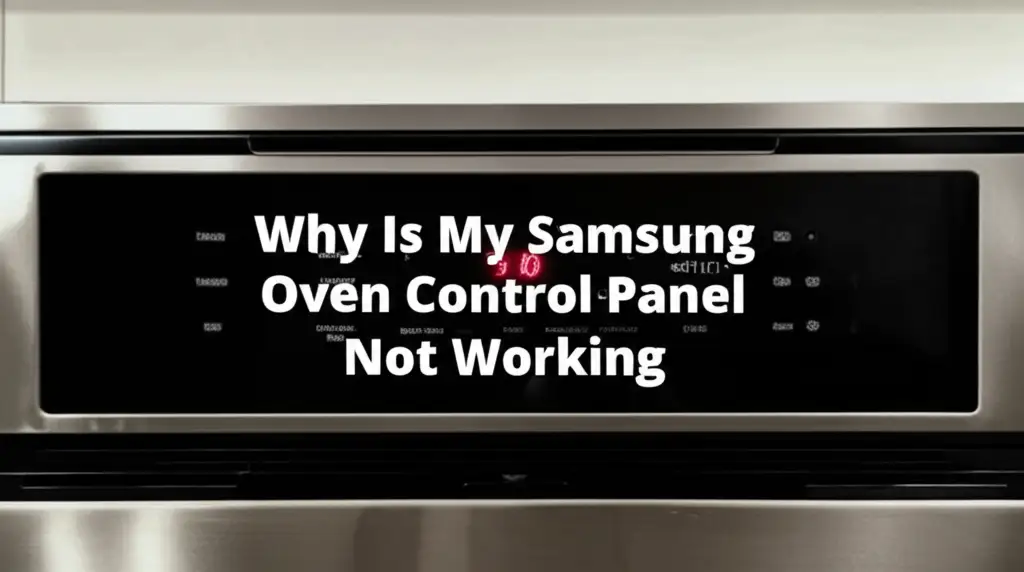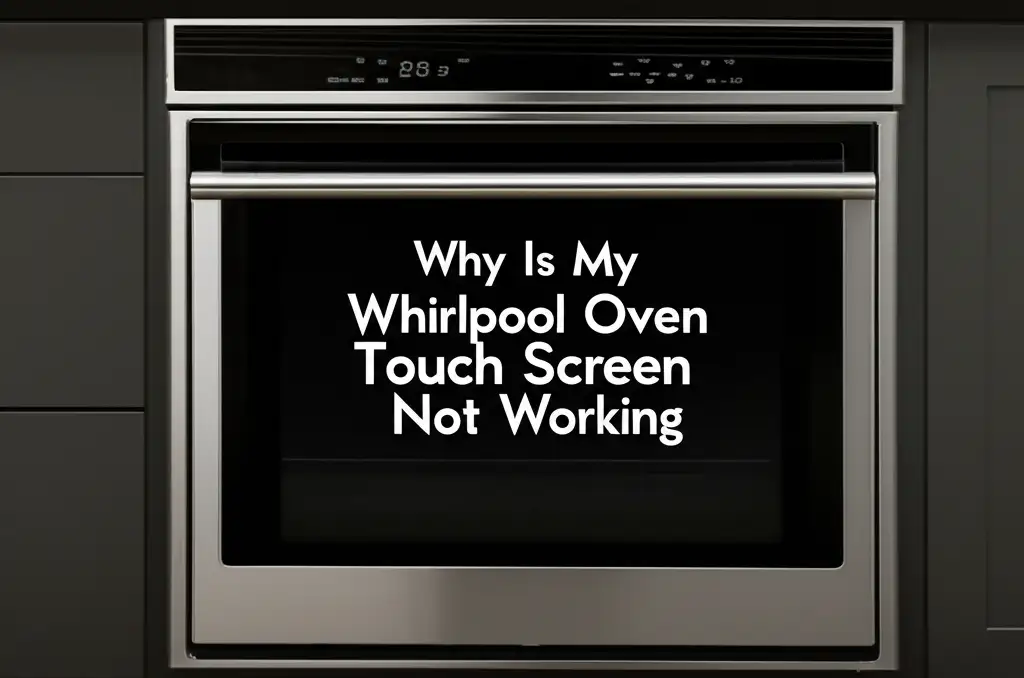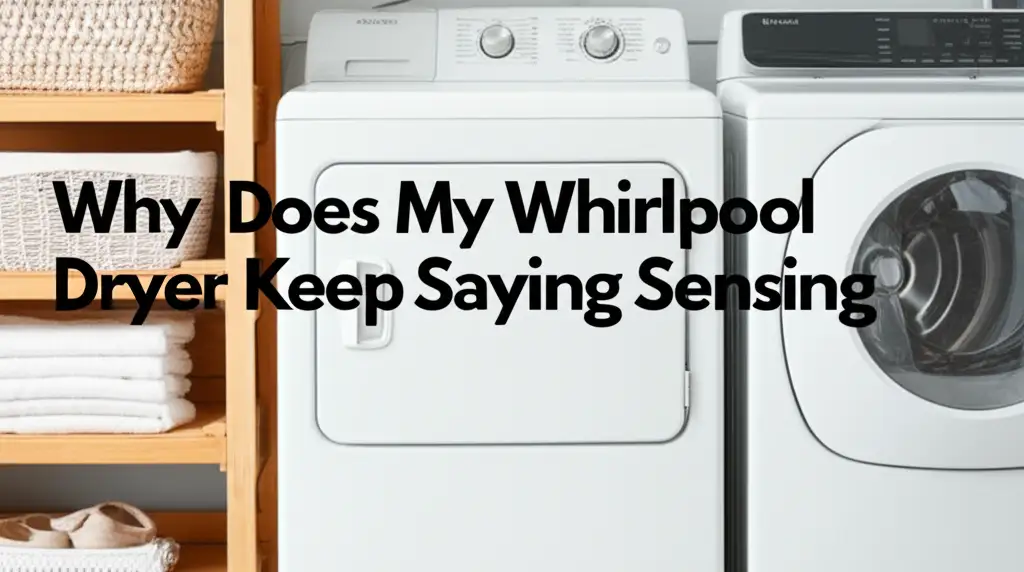· Katria Melrose · Appliance Repair · 22 min read
Why Is My Samsung Oven Control Panel Not Working

Fix Your Samsung Oven Control Panel Not Working Issues
It can be very frustrating when your Samsung oven control panel stops responding. I know the feeling of trying to bake dinner only to find the display frozen or completely blank. A non-working control panel prevents you from setting temperatures, choosing cooking modes, or even starting the oven. This issue can stem from various sources, ranging from simple fixes to more complex component failures.
We will explore common reasons why your Samsung oven control panel not working problem occurs. You will learn easy troubleshooting steps you can perform yourself. This guide covers power supply problems, accidental child lock activation, moisture damage, and internal component failures. By following these steps, you can diagnose the issue and potentially restore your oven’s functionality quickly. Let us get your Samsung oven back in working order.
Takeaway
- Check power supply and circuit breakers first.
- Disable the child lock or control lock feature.
- Clean the control panel for moisture or residue.
- Perform a power reset (soft and hard).
- Inspect internal ribbon cables and connections.
- Consider control board or overlay replacement for persistent issues.
- Contact a qualified technician for complex repairs.
Your Samsung oven control panel may not work due to power interruptions, an activated child lock, software glitches requiring a reset, or physical damage like moisture. Internal component failures, such as a faulty control board, ribbon cable, or thermal fuse, also stop the panel from responding.
Immediate Checks for a Non-Responsive Samsung Oven Control Panel
When your Samsung oven control panel is not working, the first step is always to check the basics. Sometimes, the problem is much simpler than it seems. I always start by ensuring the oven has power. This involves looking at the outlet and the circuit breaker.
Is Your Oven Plugged In and Receiving Power? First, check if the oven is properly plugged into the electrical outlet. Sometimes, the plug can come loose. Make sure it sits securely in the wall socket. Next, verify that the outlet itself has power. You can test this by plugging in a small appliance, like a phone charger, to see if it works. If the outlet has no power, the issue might be with your home’s electrical system, not the oven.
Checking Your Home’s Circuit Breaker Ovens draw a lot of power, and sometimes they can trip a circuit breaker. This is a safety mechanism to prevent electrical overloads. Go to your home’s electrical panel. Look for a breaker that is in the “off” position or in the middle (tripped) position. If you find one, flip it completely to the “off” position first, then firmly flip it back to the “on” position. Wait a few moments, then check your oven control panel again. This simple reset often restores power and fixes the issue. If the breaker trips again immediately, this indicates a larger electrical problem or a fault within the oven itself, which requires professional attention.
Initial Power Reset Steps A quick power reset can clear minor glitches. Unplug the oven from the wall outlet. If you cannot reach the plug, turn off the circuit breaker for the oven at your electrical panel. Wait for about 5-10 minutes. This allows any residual electrical charge to dissipate and the internal system to fully reset. After the waiting period, plug the oven back in or flip the circuit breaker back on. Then, check if the control panel now responds. This step often resolves temporary software or electronic issues that cause the panel to freeze or go blank. This basic troubleshooting step is similar to what you might do if your Samsung microwave not working but has power.
Understanding the Samsung Oven Child Lock or Control Lock
Many Samsung ovens include a child lock or control lock feature. This feature prevents accidental use or changes to settings, especially useful in homes with children. However, it is a common reason why your Samsung oven control panel might seem unresponsive. I have encountered this many times myself; it is easy to accidentally activate.
Identifying if the Child Lock Is Active When the child lock is on, the control panel typically shows a specific indicator. This might be a padlock icon, a key icon, or the words “Loc” or “Control Locked” on the display. The exact indicator varies depending on your specific Samsung oven model. If you see any of these symbols, it is a strong sign that the control panel is locked. The buttons will not respond to your touches when this feature is active.
How to Deactivate the Child Lock Feature Deactivating the child lock is usually a straightforward process. For most Samsung oven models, you need to press and hold a specific button for a few seconds. This button is often labeled “Lock,” “Control Lock,” or “Start/Set” with a lock symbol next to it.
- Press and Hold: Locate the “Lock” or “Control Lock” button on your panel. Press and hold it down for 3 to 5 seconds.
- Confirmation: The lock indicator on the display should disappear, or you might hear a beep. This confirms the lock is off.
- Test Panel: Try pressing other buttons on the control panel to see if they now respond.
If your oven has a touch screen, the process is similar. You might need to press and hold a virtual lock icon on the screen. Always refer to your Samsung oven’s user manual for the precise instructions for your model. If you need more detailed instructions on how to disable this function, you can refer to information on how to unlock my Samsung stove oven. This simple step resolves many “non-working” control panel complaints.
Moisture and Residue Impacting Your Samsung Oven’s Touch Panel
Moisture and residue are silent culprits behind many control panel malfunctions. The delicate electronic components of a touch panel are sensitive to liquids and grime. Even a small amount can cause significant issues. I often see this after cleaning sessions or spills.
Impact of Spills and Cleaning Agents If water or cleaning solutions seep beneath the surface of your control panel, they can short-circuit the internal wiring. This causes buttons to become unresponsive, or the display to act erratically. I always recommend using a damp cloth, not a soaking wet one, for cleaning. Harsh chemical cleaners can also leave a residue that interferes with touch sensitivity. They can also degrade the panel’s surface over time, leading to poor conductivity.
Cleaning the Control Panel Safely To clean your Samsung oven’s control panel effectively and safely, follow these steps:
- Power Off: Always turn off the oven and disconnect it from power before cleaning. This prevents accidental activation and protects you from electric shock.
- Damp Cloth: Use a soft, clean cloth dampened with only water or a very mild, non-abrasive cleaner specifically designed for electronics.
- Wipe Gently: Gently wipe the surface of the control panel. Do not spray cleaners directly onto the panel. Spray the cloth instead.
- Avoid Excess Moisture: Ensure no liquid drips into seams or gaps around the buttons or display.
- Dry Thoroughly: After cleaning, use a dry, soft cloth to wipe away all moisture. Let the panel air dry completely for at least 15-30 minutes before restoring power. This ensures any trapped moisture evaporates.
Dealing with Trapped Moisture or Condensation Sometimes, moisture can get trapped inside the control panel, especially in humid environments or after extensive cleaning. If you suspect trapped moisture, try these steps:
- Disconnect Power: Again, disconnect the oven from its power source.
- Air Dry: Leave the oven door slightly ajar and allow the oven to air dry for several hours, or even overnight. You can also use a fan directed at the control panel area to help circulate air.
- No Heat: Do not use a hairdryer or any other heat source to dry the panel. Excessive heat can damage the delicate electronics.
- Patience: Wait until you are certain the panel is completely dry before reconnecting power. Patience here prevents further damage. This careful approach helps avoid similar issues if your Samsung oven touch screen not working.
Software Glitches and How to Reset Your Samsung Oven
Like any modern appliance, Samsung ovens run on software that can sometimes encounter glitches. These glitches can cause the control panel to freeze, become unresponsive, or display error codes. A simple reset often clears these issues. I recommend trying both a soft reset and a hard reset.
Performing a Soft Reset A soft reset is the quickest and easiest way to clear minor software bugs. It is like restarting your computer or smartphone.
- Locate the Circuit Breaker: Go to your home’s electrical panel.
- Turn Off Power: Find the circuit breaker labeled for your kitchen or oven and switch it to the “off” position.
- Wait: Leave the power off for about 2-5 minutes. This allows the internal capacitors to discharge and the system to completely power down.
- Restore Power: Flip the circuit breaker back to the “on” position.
- Test: Check if the control panel now responds. This often resolves temporary communication errors between the control board and the panel.
Executing a Hard Reset or Factory Reset (Use with Caution) A hard reset, sometimes called a factory reset, clears all settings and returns the oven to its default state. This should be a last resort for software issues, as you will lose any customized settings like clock time or temperature calibration. I advise checking your user manual for exact instructions, as the process varies by model.
- Consult Manual: Your Samsung oven user manual will have specific steps for a hard reset. Look for sections on “troubleshooting,” “resetting,” or “error codes.”
- Button Combinations: Typically, it involves pressing and holding a specific combination of buttons on the control panel for an extended period (e.g., “Start/Set” and “Cancel” simultaneously for 10-15 seconds).
- Confirmation: The display might show a confirmation message, or the oven might beep.
- Reprogram Settings: After a hard reset, you will need to reprogram the time, date, and any other personalized settings.
When to Consider Firmware Updates Modern Samsung ovens sometimes have firmware that can be updated. Firmware updates fix bugs and improve performance. If your oven is connected to Wi-Fi and the SmartThings app, check for available updates.
- SmartThings App: Open the Samsung SmartThings app on your phone.
- Check for Updates: Navigate to your oven’s device settings. Look for an option to check for firmware updates.
- Follow Prompts: If an update is available, follow the on-screen prompts to download and install it.
- Stable Connection: Ensure your oven has a stable Wi-Fi connection during the update process to prevent interruptions.
- Caution: Never interrupt a firmware update. This can brick the control board and require professional repair. Updates can sometimes resolve persistent software-related unresponsiveness of the control panel.
Faulty Ribbon Cable Connections in Your Samsung Oven Display
The control panel often connects to the main control board via delicate ribbon cables. These flat, flexible cables transmit signals and power. If a ribbon cable becomes loose, damaged, or corroded, your Samsung oven control panel may stop working. This is a common point of failure I look for.
Understanding Ribbon Cable Function Ribbon cables are essential for communication. They carry data from the touch-sensitive overlay to the main control board, which then processes your commands. They also send display information back to the screen. A good connection is critical for the panel to function. If the cable is compromised, signals cannot pass through correctly. This leads to an unresponsive panel, blank display, or erratic behavior where buttons seem to press themselves.
How to Inspect and Reseat Ribbon Cables Inspecting ribbon cables requires opening the oven’s control panel housing. This involves working with electrical components, so always disconnect power to the oven first by unplugging it or turning off the circuit breaker. If you are not comfortable with this step, call a professional.
- Access the Control Panel: You usually need to remove screws around the back or top of the control panel to access the internal components. The specific disassembly steps vary by model, so consulting your service manual is highly recommended.
- Locate Ribbon Cables: Once the housing is open, carefully locate the ribbon cables. They look like wide, flat strips with multiple thin wires, often colored or metallic, connecting the display and touch overlay to the main control board.
- Visual Inspection: Examine the cables for any signs of damage. Look for:
- Creases or Bends: Sharp folds can break internal wires.
- Tears or Fraying: Physical damage affects signal integrity.
- Corrosion: Green or white powdery residue indicates moisture damage, which can disrupt electrical flow.
- Burn Marks: Discoloration suggests overheating or a short circuit.
- Reseat Connections: Gently disconnect the ribbon cables from their connectors. Most have small clips or levers that you lift to release the cable. Carefully reinsert them, ensuring they are seated firmly and straight. Make sure the clips or levers are secured back down. A loose connection is a very common cause of panel issues.
When a Ribbon Cable Needs Replacement If you find a ribbon cable that is visibly damaged (torn, deeply creased, or burned), reseating it will not fix the problem. The cable needs replacement.
- Part Identification: Note the part number of the damaged cable. This is often printed directly on the cable itself.
- Order New Part: Order an exact replacement from a reputable appliance parts supplier.
- Professional Help: If the damage is extensive, or if you are unsure about the replacement process, it is best to call a qualified appliance technician. Replacing internal components like ribbon cables can be delicate. Mishandling can cause further damage to the control board or display. This type of detailed internal check is more involved than just how to clean a remote control.
Identifying a Defective Samsung Oven Control Board or Overlay
If basic troubleshooting steps like power resets, child lock deactivation, and cleaning do not resolve the issue, the problem might lie with the main control board or the touch panel overlay. These are central components for the oven’s operation. I often find these are the culprits for persistent control panel issues.
Function of the Main Control Board The main control board, also known as the PCB (Printed Circuit Board) or “motherboard,” is the brain of your Samsung oven. It receives commands from the control panel, interprets them, and sends signals to other components like the heating elements, fan, and lights. When the control board fails, it cannot process input from the panel, leading to an unresponsive display or buttons. Failure can be due to power surges, age, or manufacturing defects.
Function of the Control Panel Overlay (Membrane Switch) The control panel overlay is the outer surface you touch, often a flexible membrane with conductive traces underneath. It is essentially a large membrane switch. When you press a “button” on the overlay, you complete a circuit, sending a signal to the control board. If the overlay gets cracked, worn out, or if its internal conductive layers separate, it cannot register touches correctly. This means signals are not sent, and the control panel seems dead or only partially responsive.
Symptoms of a Failing Control Board or Overlay
- Completely Blank Display: If the display is completely dark and unresponsive, even after power resets, it often points to a major control board failure or a complete power supply issue to the board.
- Partial Unresponsiveness: Some buttons work, but others do not. This can indicate a localized failure in the overlay or a specific circuit on the control board.
- Random Button Presses/Erratic Behavior: The oven seems to turn on by itself, or settings change without input. This is a classic symptom of a faulty control board or a “ghost touch” issue on a damaged overlay. A similar issue can be seen when your Samsung oven is turning on by itself.
- Error Codes: The display might show specific error codes related to communication failures or internal component faults. Check your oven manual for the meaning of these codes.
- Buzzing/Burning Smell: While rare, a failing control board can sometimes produce a buzzing sound or a faint burning smell if components are overheating or shorting.
Replacement Considerations and Professional Help Replacing a control board or an overlay is a more advanced repair.
- Diagnosis: Accurate diagnosis is crucial. Sometimes, a “dead” control panel is actually due to a faulty thermal fuse cutting power to the board, not the board itself.
- Part Matching: You must obtain the exact replacement part number for your specific Samsung oven model. Control boards are expensive and non-returnable if opened.
- Complexity: Replacement involves disassembling the oven’s front panel, carefully disconnecting numerous wires and connectors, and installing the new part. There is a risk of damaging other components or incorrectly wiring the new board.
- Cost: Control boards and overlays are among the most expensive components in an oven. Get a quote for the part and labor before deciding to replace it yourself or hire a professional.
- Professional Recommendation: For these complex parts, I strongly recommend hiring a qualified appliance technician. They have the diagnostic tools, experience, and access to genuine parts. They also ensure the repair is done safely and correctly. This is particularly important for electrical components.
Overheating Issues and Thermal Fuse Protection in Samsung Ovens
Samsung ovens, like many appliances, incorporate safety features to prevent overheating. One such feature is the thermal fuse. A thermal fuse is a safety device designed to cut off electrical power if the oven’s temperature exceeds a safe limit. While a crucial safety component, a blown thermal fuse will cause your Samsung oven control panel not to work.
How the Thermal Fuse Protects Your Oven The thermal fuse is a small, one-time use component. It contains a heat-sensitive element that melts and breaks the circuit if it detects extreme temperatures. This prevents the oven from continuing to heat, which could lead to fire or damage to internal components. It protects the control board and other sensitive electronics from thermal damage. When the fuse blows, it permanently interrupts the electrical path to the control board, causing the control panel to go blank and unresponsive.
Symptoms of a Blown Thermal Fuse
- Completely Dead Control Panel: This is the most common symptom. The control panel will be totally blank, and no functions will work. It will appear as if the oven has no power at all.
- Oven Not Heating: Even if the control panel had some limited function (unlikely with a blown fuse), the oven would not heat up.
- No Lights or Fan: No internal oven lights or cooling fans will operate.
Common Causes of a Blown Thermal Fuse A thermal fuse does not blow without a reason. It indicates an underlying issue causing excessive heat.
- Ventilation Issues: Blocked oven vents or restricted airflow around the oven can trap heat, leading to internal overheating. Ensure the oven’s vents are clear and not obstructed by walls or cabinetry.
- Cooling Fan Failure: The oven has a cooling fan that operates during and after cooking cycles to dissipate heat from the control board area. If this fan fails, heat can build up, causing the fuse to blow.
- Defective Heating Elements: Less common, but a faulty heating element that runs continuously or draws too much power can cause overall oven overheating.
- Control Board Malfunction: A faulty control board might incorrectly signal components to overheat, leading to the thermal fuse blowing as a safety measure.
Steps for Inspecting and Replacing a Thermal Fuse Replacing a thermal fuse requires some technical skill and always requires disconnecting power to the oven first. I advise caution with this repair.
- Disconnect Power: Unplug the oven or turn off its dedicated circuit breaker.
- Access Fuse: The thermal fuse is usually located near the oven’s control board or at the top rear of the oven cavity, often behind the back panel. You may need to remove screws to access these areas.
- Locate the Fuse: The thermal fuse looks like a small cylinder with two wires connected to it. It might be covered in insulation.
- Test for Continuity: Use a multimeter to test for continuity across the fuse. If the multimeter shows no continuity (an open circuit), the fuse is blown and needs replacement.
- Replacement: Obtain an exact replacement fuse with the same temperature rating. Incorrect rating can lead to safety hazards.
- Reassemble: Connect the new fuse, reassemble the oven panels, and restore power.
- Identify Root Cause: Simply replacing the fuse without addressing the underlying cause of overheating will lead to the new fuse blowing again. It is crucial to find and fix the reason it blew in the first place. If you are unsure, consult a professional.
Power Supply Problems Affecting Your Samsung Oven Control Panel
A consistent and correct power supply is crucial for your Samsung oven’s control panel to function. Any fluctuations, interruptions, or issues with the electrical connection can cause the panel to become unresponsive or behave erratically. I always emphasize checking the power source when diagnosing problems.
Wall Outlet Issues The wall outlet provides the initial power to your oven.
- Damaged Outlet: The outlet itself might be faulty. Worn internal contacts can lead to intermittent power. You might see burn marks around the outlet. This can also affect other appliances like a GE dishwasher control panel not working.
- Loose Connections: The wires connecting to the outlet inside the wall could be loose. This requires a qualified electrician to inspect and tighten.
- Dedicated Circuit: Ovens typically require a dedicated 240V circuit. Sharing a circuit with other high-power appliances can lead to insufficient power supply or frequent circuit trips. Ensure your oven has its own dedicated circuit.
Power Cord Damage The power cord connects the oven to the wall outlet.
- Physical Damage: Inspect the power cord for any visible signs of damage. Look for cuts, frayed wires, pinches, or burn marks. A damaged cord can prevent power from reaching the oven or cause a short circuit.
- Loose Connections at Oven: Sometimes, the power cord connects internally to the oven’s terminal block. These connections can loosen over time. If you suspect this, disconnect power and carefully inspect the terminal block connections at the back of the oven. Ensure they are tight.
Internal Wiring Problems Inside the oven, various wires distribute power from the terminal block to the control board, heating elements, and other components.
- Loose Wires: Vibrations or heat over time can cause internal wire connections to loosen. A loose wire leading to the control board or its power supply can cause the panel to lose power.
- Damaged Wires: Wires can get pinched or abraded, leading to shorts or open circuits. Look for any wires that appear burnt, melted, or have exposed copper.
- Corrosion: In humid environments, internal wiring can corrode, especially at connection points. Corrosion increases resistance and can prevent proper power flow.
Voltage Fluctuations Less common for direct panel failure but can contribute to control board issues:
- Brownouts/Surges: Periods of low voltage (brownouts) or sudden spikes (surges) can stress electronic components, potentially damaging the control board over time. Using a surge protector designed for large appliances can offer some protection, though direct wiring usually bypasses standard surge strips.
- Household Wiring Issues: Problems with your home’s main electrical service or wiring can cause inconsistent voltage delivery to appliances. If multiple appliances are experiencing unusual electrical behavior, an electrician should inspect your home’s wiring.
When to Seek Professional Electrical Help Diagnosing and repairing internal wiring or outlet issues often requires specialized tools and electrical knowledge.
- Safety First: Working with high voltage electricity is dangerous. If you are not comfortable or experienced with electrical repairs, do not attempt them.
- Qualified Electrician: For issues beyond a simple plug check or circuit breaker reset, contact a qualified electrician. They can safely test outlets, inspect internal wiring, and diagnose voltage problems.
- Appliance Technician: If the power issue is confirmed to be internal to the oven (e.g., a wire directly to the control board), an appliance technician is best equipped to handle that specific repair within the oven.
When to Call a Professional for Your Samsung Oven Repair
While many issues can be fixed with DIY troubleshooting, there are clear instances when calling a professional appliance technician is the best and safest course of action. I always advise people to know their limits when dealing with electrical appliances.
Complex Internal Component Failures If your troubleshooting points to issues with the main control board, the thermal fuse, internal wiring, or the oven’s heating elements, it is time to call an expert. These repairs involve:
- Specific Diagnostic Tools: Technicians have specialized tools to accurately test voltage, continuity, and component functionality. This helps them pinpoint the exact faulty part without guesswork.
- Knowledge of Schematics: They understand the complex wiring diagrams and internal schematics of Samsung ovens, allowing for efficient and correct diagnosis.
- Safe Handling of High Voltage: Working inside an oven exposes you to high voltage components, even when unplugged (capacitors can retain charge). Professionals are trained in safety protocols to prevent electric shock.
- Part Sourcing: Technicians have access to genuine OEM (Original Equipment Manufacturer) parts, which are crucial for ensuring proper fit and long-term reliability. Generic parts might not perform as well or last as long.
Safety Concerns and Electrical Hazards Any situation involving potential electrical hazards warrants professional intervention.
- Burning Smells or Smoke: If you detect any burning smell, see smoke, or notice scorch marks, immediately unplug the oven and call a professional. This indicates an active electrical short or overheating component.
- Repeated Circuit Breaker Trips: If the oven repeatedly trips the circuit breaker after you reset it, there is a serious electrical fault within the oven or your home’s wiring. This needs immediate attention from an electrician or appliance technician.
- Visible Damage to Wiring: If you see frayed, melted, or otherwise damaged wires inside the oven, do not attempt to touch or repair them. This is a significant fire hazard.
Lack of Confidence or Experience If you feel unsure at any point during the troubleshooting process, or if you are not comfortable disassembling parts of your oven, it is perfectly fine to stop and call for help.
- Prevent Further Damage: Attempting a repair beyond your skill level can lead to more damage to the oven, increasing repair costs. You could also inadvertently void your warranty if you open sealed components.
- Time and Effort: A professional can often diagnose and fix the problem much faster than a homeowner struggling with complex repairs. Your time is valuable.
Warranty Considerations Check your Samsung oven’s warranty. If it is still under warranty, attempting DIY repairs might void it. In such cases, contacting Samsung’s customer service or an authorized service center is the best approach. They will handle the repair under warranty terms.
Cost-Benefit Analysis Consider the age of your oven and the cost of the repair. If the repair cost approaches or exceeds half the price of a new oven, it might be more economical to replace the appliance. A technician can provide an estimate to help you make this decision. For instance, if your Samsung oven is not getting hot enough and the repair is costly, replacement might be a better choice.
FAQ Section
Q1: Why is my Samsung oven control panel completely blank? A1: A completely blank control panel on your Samsung oven most often indicates a total power loss to the control board. This can be due to a tripped
- samsung oven control panel not working
- samsung oven repair
- oven display issues
- control panel troubleshooting
- samsung appliance problems
- oven not responding
- oven touch screen
- appliance diagnostics





